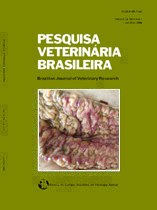 |
|
|
|
Year 2013 - Volume 33, Number 12
|

|
Virulence and biofilm formation by Enterococcus faecalis isolates from cloacal swabs of broilers infected with Eimeria spp., 33(12):1433-1440
|
ABSTRACT.- Cassenego A.P.V., Ellwanger J., d’Azevedo P.A., Ribeiro A.M.L., frazzon J. & frazzon A.P.G. 2013. [Virulence and biofilm formation by Enterococcus faecalis isolates from cloacal swabs of broilers infected with Eimeria spp.] Virulência e formação de biofilme microbiano por Enterococcus faecalis isolados de swabs cloacais de frangos de corte infectados com Eimeria spp. Pesquisa Veterinária Brasileira 33(12):1433-1440. Departamento de Microbiologia, Instituto de Ciências Básicas da Saúde, Universidade Federal do Rio Grande do Sul, Rua Sarmento Leite 500, Porto Alegre, RS 90050-170, Brazil. E-mail: ana.cassenego@ufrgs.br
The microbiota dynamics in the gastrointestinal tract (GT) of animals can be disrupted by pathogens, such as Eimeria spp. Enterococci are saprophytic bacteria that colonize the GT of mammals and birds. The influence on the intestinal microbiota is related to the adaptive capacity of bacteria to adhere to host cells and colonize the mucosal cells. The aim of this study was to analyze the frequency of virulence genes ace, agg and bopABCD operon in Enterococcus faecalis isolated from cloacal swabs of broilers challenged with Eimeria spp. and fed with a standard diet supplemented or not with anticoccidial (monensin), and, also to evaluate for the ability of these strains to form biofilms under in vitro conditions. A total of 70 E. faecalis were selected and the agg gene was more frequent in strains isolated from the broilers treated with anticoccidial (92.3%) when compared to the group that not received anticoccidial (70.5%). On the other hand, the ace and bopABCD operon genes showed no significant difference between the two groups of broilers (P>0.005). The E. faecalis isolated from the broilers treated with anticoccidial showed a higher frequency of strong biofilm formation when growing in medium supplemented with glucose (92.3-88.5%) and urine (77%) when compared with enterococci isolated from broilers that not received anticoccidial. It was observed that E. faecalis isolated from broilers treated with anticoccidial showed a higher frequency of virulence factors genes and stronger biofilms formation, indicating better adaptation of the isolates in healthy intestinal environment. |
| |
|
|
| |
|
 |